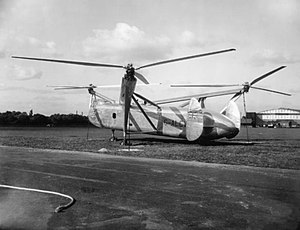Cierva Air Horse
| W.11 Air Horse | |
|---|---|
 |
|
| Rear view, the three rotors can be seen | |
| Role | Single-engine three-rotor helicopter |
| Manufacturer | Cierva Autogiro Company |
| Designer | Cyril Pullin |
| First flight | 7 December 1948 |
| Retired | 1950 |
| Primary user | Ministry of Supply |
| Number built | 2 |
| Developed from | Weir W.6 |
The Cierva W.11 Air Horse was a helicopter developed by the Cierva Autogiro Company in the United Kingdom during the mid-1940s. The largest helicopter in the world at the time of its debut, the Air Horse was unusual for using three rotors mounted on outriggers, and driven by a single engine mounted inside the fuselage.
The W.11 "Air Horse" heavy lift helicopter was developed by the G & J Weir, Ltd., Aircraft Department, reconstituted in 1943 as the Cierva Autogiro Company. The "W" in the designation is a continuation of the autogiro and helicopter series developed by G & J Weir, Ltd., during the period 1932–1940.
The W.11 was a development of the Weir W.6 dual transverse rotor helicopter. It is the only helicopter of its type ever built and included three lifting rotors all turning in the same direction. The adoption of three rotors was due to concerns over the capability of a single large rotor to generate the required lift.
Torque balance was provided by slightly inclining each rotor axis to generate horizontal thrust components to provide anti-torque moments. The three rotor configuration was foreseen by Belgian helicopter experimenter Nicolas Florine in his patent of 1926 which presented the aforementioned means for balancing the reaction on the fuselage of two or more torque driven lifting rotors turning in the same direction.
Work on the W.11 commenced in 1945. The original W.11 configuration used two rotors transversely mounted either side at the tail of the fuselage and a single rotor mounted on the centerline on the front. This configuration was tested in 1947 with a scale-model in a wind tunnel at the Royal Aircraft Establishment at Farnborough, and much useful data on its performance was acquired. This determined that a single rotor at the front and the pair at the back of the fuselage was preferred for optimum stability and control.
A Rolls-Royce Merlin piston engine in the fuselage drove three 47-foot-diameter (14 m) three-blade rotors mounted on outriggers which projected from the fuselage. The blades, following the Focke-Achgelis designs, were constructed from resin-impregnated wood, which provided enormous strength, and were manufactured by the Glasgow furniture firm H. Morris & Co., Ltd. The W.11 rotor control system was hydraulically powered. It was the second helicopter ever to fly using such a system, the first being the Cierva W.9. The landing gear had a stroke of 5 ft (1.5 m) to cater for high descent rates in the event of engine failure during low-altitude operations.
...
Wikipedia
